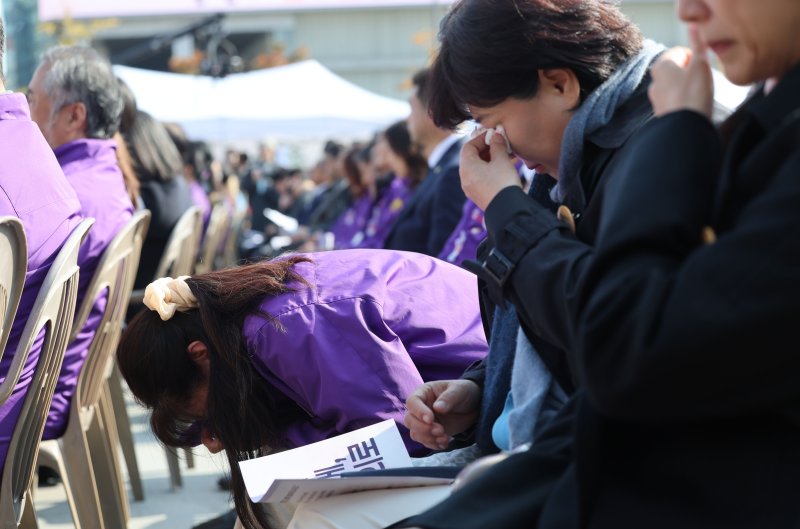Repeated After Every Major Disaster... 'Secondary Victimization' That Hurts Victims Twice
- Input
- 2025-10-29 16:26:33
- Updated
- 2025-10-29 16:26:33

[Financial News] Although it has been three years since the Seoul Halloween crowd crush claimed 159 lives, secondary victimization against the victims and the bereaved families continues. Online, comments mocking or insulting the victims persist, causing the bereaved families renewed pain. Experts advise that, before police investigations begin, people should recognize that their online posts could inflict secondary harm on the bereaved families.
According to the Korean National Police Agency (KNPA) on the 29th, a total of 166 reports of secondary victimization related to the Seoul Halloween crowd crush have been filed with the police so far. Of these, 19 cases have been referred for prosecution, while 26 have been closed due to lack of evidence or other reasons. Since July, the police have established a dedicated investigation team to address secondary victimization crimes targeting victims of major disasters and incidents. To prevent further harm, authorities are also working with media outlets to close comment sections on articles about the disaster.
Secondary victimization refers to acts that inflict further harm on those who have already suffered primary damage. This often manifests as blaming the victims, mocking their pain, or distorting the facts of the incident. The police, who established the Secondary Victimization Crime Investigation Team in July, reported that as of the 27th of this month, they had received 166 reports of secondary victimization related to the Seoul Halloween crowd crush, closing 45 cases and continuing investigations into 121. Cyber Crime Investigation Units across the country have also set up dedicated systems for handling secondary victimization, while cyber honorary police such as NuriCops are closely monitoring related online posts.
Nevertheless, malicious and indiscriminate posts continue to appear online. A review by this newspaper of social media platforms such as YouTube found that posts blaming, belittling, or mocking the victims of the Seoul Halloween crowd crush are frequently uploaded.
As a result, the bereaved families continue to suffer greatly from secondary victimization even after the disaster. Song Hae-jin, an executive member of the Itaewon Tragedy Bereaved Families Association, stated at a recent citizens' memorial event, "Three years have passed since the tragedy, but the bereaved families have had to fight not only the grief of losing their children, but also a government that avoids responsibility and relentless secondary victimization targeting the victims and their families." She added, "Even now, the bereaved families and victims are struggling with trauma, while some people continue to mock them online."
Such secondary victimization has been repeated after every major disaster or tragedy. After the Jeju Air passenger plane crash at Muan Airport in December last year, the bereaved families reported suffering severe pain due to defamatory comments and public criticism. Similar patterns of secondary victimization were also observed following the Osong Underpass Disaster and the Sinking of MV Sewol, with bereaved families and victims expressing their distress.
Experts point out that the repeated occurrence of secondary victimization after major disasters stems from a desensitized and distorted attitude toward the suffering of others. Myung Ho Lim, a professor of psychology at Dankook University, explained, "Those who engage in secondary victimization often do so not with a specific purpose, but because they seek attention and recognition online. Most are unaware that they are committing secondary harm and act without considering the perspective of the victims."
The problem is that such actions go beyond verbal attacks and inflict even greater wounds on the victims. Keumjoo Kwak, a professor of psychology at Seoul National University (SNU), emphasized, "Blaming and criticizing the victims for the tragedy is another form of violence, equivalent to inflicting harm on someone who is defenseless. As a result, it becomes even harder for victims and bereaved families to escape negative emotions and circumstances, and witnessing secondary victimization online can lead to imitation and further complicity."
Accordingly, experts stress the need to restore social trust and establish a victim-centered communication structure to break the vicious cycle of secondary victimization after disasters.
Sim Minyoung, head of the National Center for Trauma, stated, "Instead of protecting the wounds of victims after a disaster, secondary victimization is creating new ones." He added, "The most important thing is to restore social trust so that follow-up processes such as fact-finding investigations are carried out thoroughly, and to ensure honest communication among all parties involved."
Meanwhile, President Lee Jae Myung sent a video message to the memorial ceremony at Gwanghwamun Square on the third anniversary of the tragedy, pledging, "We will reflect on everything, from the inadequate response and irresponsible avoidance to the insufficient apologies and condolences, and correct each one." The political community also announced plans to pass an amendment to the Special Act on Protection of Rights of Sufferers, Truth-Finding, and Prevention of Recurrence of the October 29 Itaewon Crowd Crush, which includes provisions to prevent secondary victimization of the bereaved families. This is the first time the government has held an official memorial event with the bereaved families since the Seoul Halloween crowd crush.
welcome@fnnews.com Yuha Jang, Seo Ji-yoon Reporter